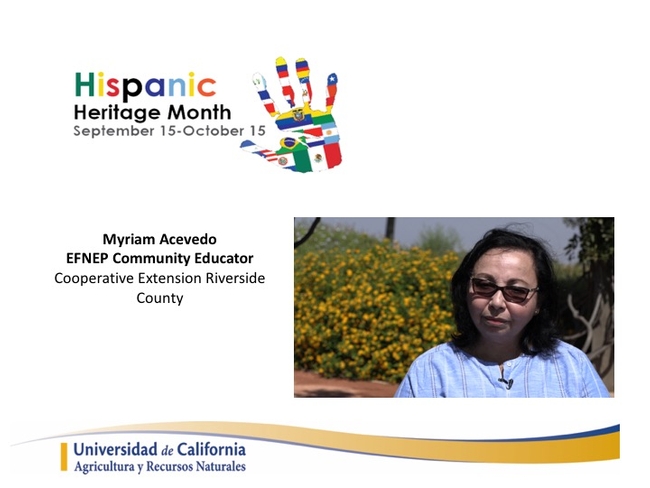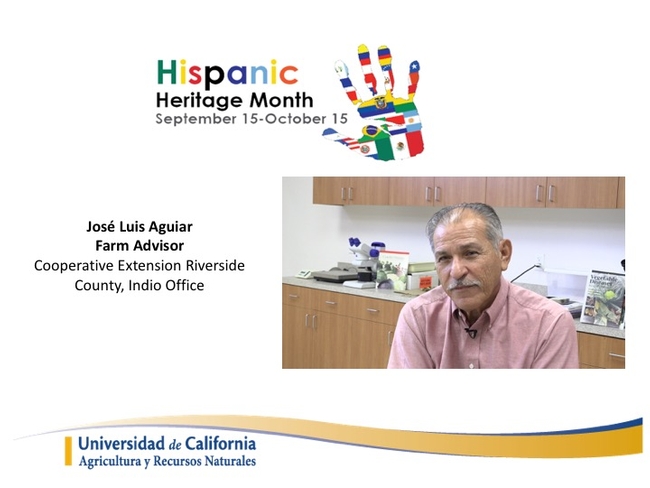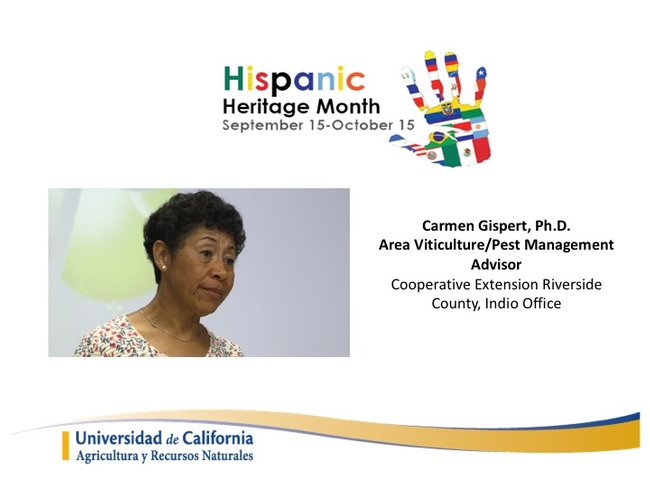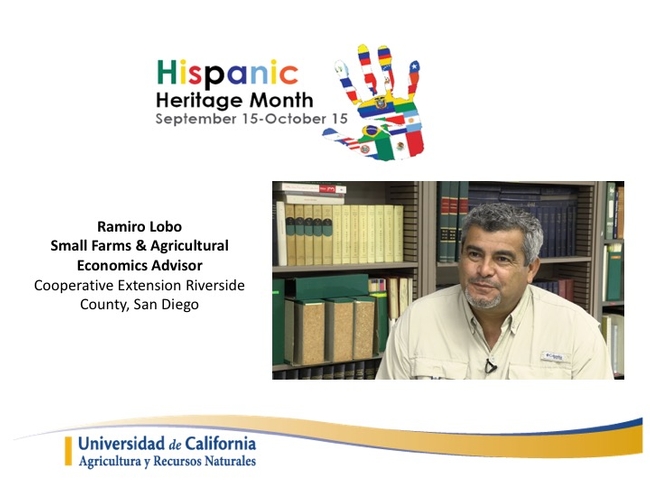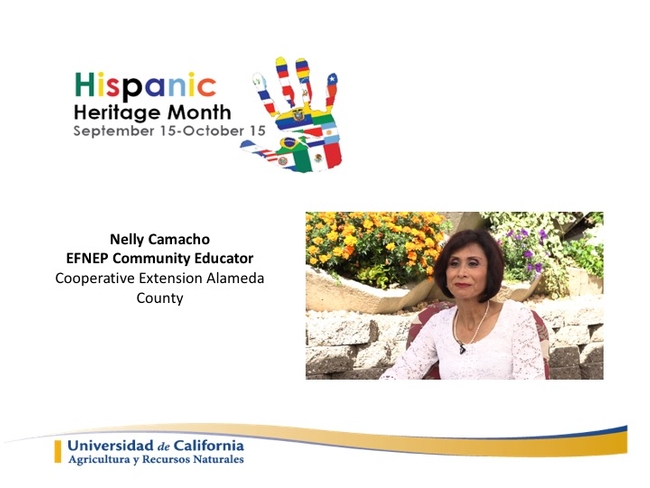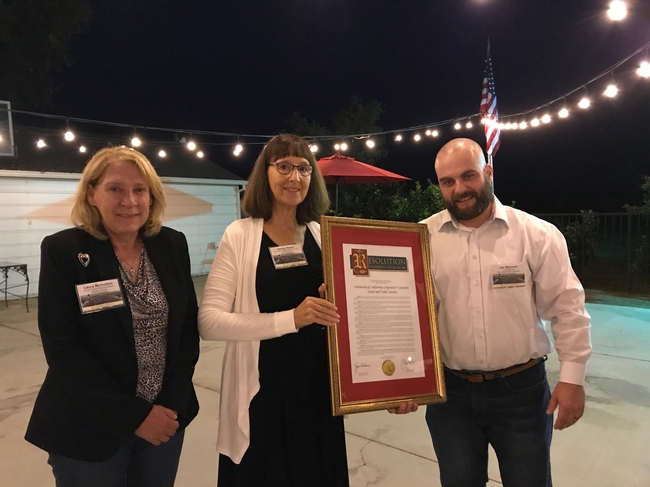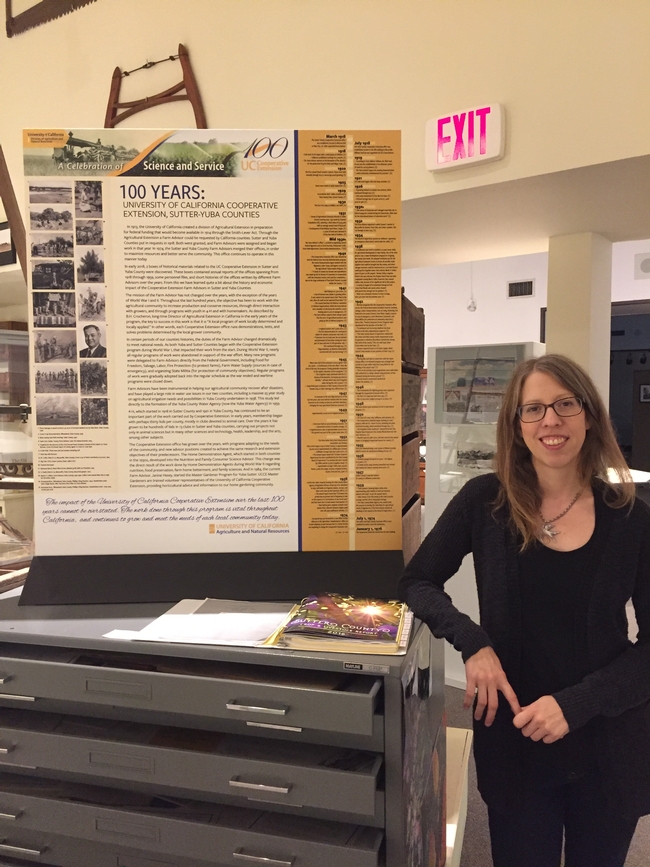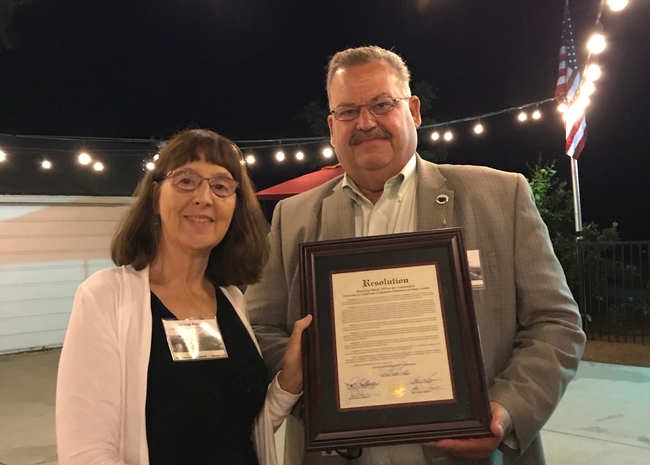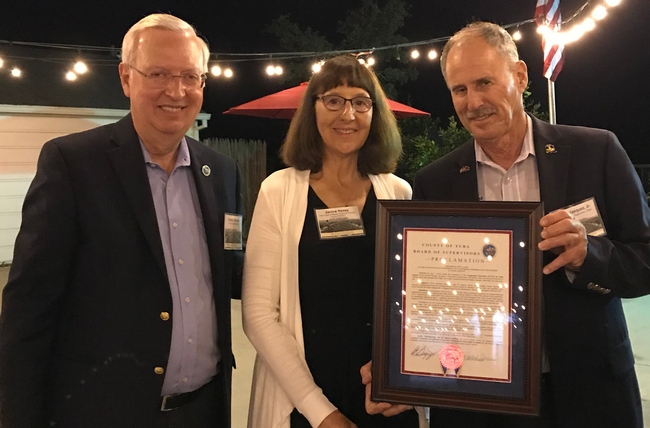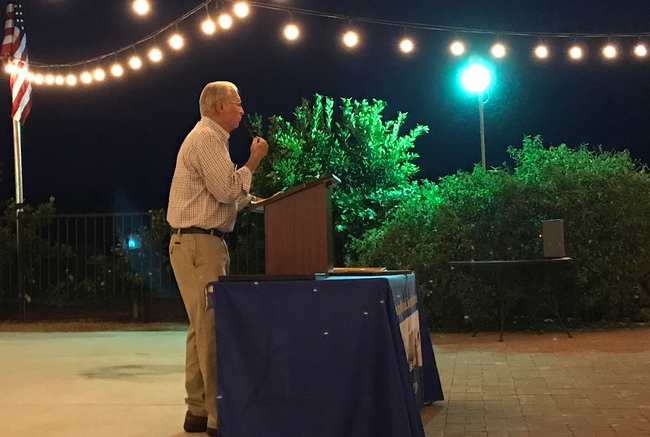4-H & Families
ANR celebrates Hispanic Heritage Month
Each year, during Hispanic Heritage Month – from September 15 to October 15 – the country celebrates the culture and contributions of those whose ancestors came from Spain, Mexico, the Caribbean and Central and South America. Latinos comprise 40 percent of California's population and a growing portion of ANR's clientele. The work and contributions of Latino ANR members help to customize ANR's outreach for the Latino community, from immigrants to native-born citizens.
“We greatly appreciate the insight and skills of ANR's Latino academics, educators and staff members,” said VP Glenda Humiston. “They enable us to better serve the diverse population of California.”
This year, News and Information Outreach in Spanish, or NOS, is highlighting the work of five Hispanic ANR members whose passion to work in their communities have contributed to better lives for their fellow residents.
“The Latino community is thriving, and growing politically and financially with the help of ANR,” said Ricardo Vela, NOS manager.
NOS has produced videos showcasing the work of Myriam Acevedo, UCCE nutrition educator in Riverside County; Nelly Camacho, UCCE food educator in Alameda County; Carmen Gispert, UCCE area viticulture and pest management advisor based in Indio; Ramiro Lobo, UCCE small farms and agricultural economics advisor in San Diego County; and José Luis Aguiar, UCCE agricultural advisor for Riverside County based in Indio.
See their stories at http://espanol.ucanr.edu, Facebook at https://www.facebook.com/ucnos, and Twitter @UCANRnos.
UCCE Sutter-Yuba celebrates 100 years
UC Cooperative Extension in Sutter and Yuba counties is celebrating a century of serving its community.
“Earlier this year, we unexpectedly found two boxes full of our historical records,” said Janine Hasey, director of UCCE Sutter-Yuba counties. “In those boxes were original reports and photos from 1918 through 1959 for both Sutter and Yuba counties.” The counties merged into one UCCE office in 1974 located in Yuba City.
Sutter County administrator Scott Mitnick paid tribute to UCCE in his blog, writing:
“The Community Memorial Museum of Sutter County conducted a great deal of research into the 100-year history of the Agricultural Extension and discovered that the UC Cooperative Extension has been helping to solve agricultural industry problems from its beginnings. They've tested new crops - they abandoned cotton as a failure here in 1926 - conducted demonstrations on proper tree pruning practices, advocated for the establishment of an adequate system of rural roads, and have played pivotal roles in pest management, best irrigation management practices and orchard nutrition. In 1927 they placed bees in almond orchards and yields increased by 158 percent. Varieties developed by the UC Cooperative Extension make up 85 percent of California's walnut industry. Seven years after introducing safflower in 1950, more safflower was grown in Sutter County than any other in the United States.”
With Hougen's assistance, the UCCE Sutter-Yuba staff wrote articles highlighting UCCE's contributions to the local agriculture industry, which Agricultural Commissioners Lisa Herbert of Sutter County and Steve Scheer of Yuba County published in their annual crop reports.
Beginning on page 15, the 2017 Yuba County Crop Report outlines the history of UCCE in the county, starting with the hiring of William Harrison as Yuba County's first UCCE farm advisor on July 1, 1918, then listing a timeline of contributions that resulted in economic benefit to farmers and reduced impacts on the environment.
The first two pages of the 2017 Sutter County Crop and Livestock Report list major contributions of UCCE to the county over the past 100 years, with a sidebar focusing on rice.
“Our partnership goes back to our first farm advisors, who were housed in the same buildings with the ag commissioners in each county,” Hasey said.
UCCE Sutter-Yuba staff invited elected and appointed officials, 4-H and Master Gardener volunteers, farmers, former UCCE employees, UCCE specialists and UC faculty collaborators, commodity board members and others to celebrate the local UCCE centennial Aug. 24 at John Heier Historic Howard House at the foot of the Sutter Buttes.
After dinner, the guests were given an overview of UCCE history by Chris Greer, UCCE area IPM advisor and former UCCE Sutter-Yuba director and former ANR vice provost of Cooperative Extension. David Ramos, UCCE specialist emeritus and former California Walnut Board research director, who started his UC career as an extension assistant in Sutter County in 1959, provided his perspective on UCCE for the past 60 years.
During the event, Hasey was presented a Senate/Assembly Resolution for UCCE Sutter-Yuba by Laura Nicholson, senior district representative for state Senator Jim Nielsen, and Joe Brennan, who represented Assemblymember James Gallagher. Sutter County Supervisor Mat Conant presented Hasey with a resolution on behalf of Sutter County and Andy Vasquez, Jr., chair of the Yuba County Board of Supervisors, and Supervisor Randy Fletcher, presented a Yuba County Proclamation.
“It is recognition of our value to the community that the boards of supervisors in both counties have funded our operating budget for CE for 100 years for a non-mandated program,” Hasey said in her closing remarks. “Back in the 1920s and early 1930s, the Giannini Foundation at UC Berkeley did a six-year study on the value of Cooperative Extension in Sutter County and found it was over $3 million dollars for that time period. I'm not aware of another study that has determined the value of CE to these counties since then. We thank you, Sutter and Yuba supervisors, for supporting CE's operating budgets for 100 years!”
The Marysville Appeal-Democrat's Chris Kaufman interviewed Hasey, Ramos and local 4-H leader Nancy Perkins for an article about UCCE published Sept. 30.
“When I started in Sutter County, Hartley was the leading walnut and all the others in production were varieties that were brought in from Europe and elsewhere,” Ramos told Kaufman. “Today, virtually all the walnut acreage is almost all university-developed. It revolutionized the nature of the industry with higher quality and more production.”
ANR funding support update
Colleagues,
As mandated costs continue to outpace available funds, UC ANR is taking action to ensure financial prudence while continuing to devote our limited resources to our priorities. These include the approved systemwide merit program and the two UC ANR equity programs designed to improve the competitiveness of salaries for academics and staff, among other goals. As Vice President Humiston recently said, “People are our greatest asset; without you, we cannot achieve our research and extension mission.” Please see related programmatic funding updates below.
Program Team Funding
- For FY2018-19, UC ANR is providing funding for Program Team meetings, during which related Workgroups can also meet. These meetings provide the opportunity to network, share and learn. To find out about the meetings, check the Program Team meetings web page.
- Over this coming year, UC ANR program leadership will continue to solicit input on opportunities to improve our Strategic Initiative, Program Team and Workgroup structure and roles. Thanks to Program Team Leaders and Workgroup Chairs who provided input through the August survey.
CE specialist and AES travel funds to work with CE advisors or at the RECs
- Continuing in FY 2018-19, UC ANR is making travel support available for CE specialists to collaborate with UC ANR academics off-campus, including CE advisors in the counties and UC ANR academics at the research and extension centers. Each specialist may apply for up to $2,500. These travel funds must be expended by June 30, 2019, and used by the UCCE specialists only, and cannot be used for out-of-state travel.
- UC ANR continues to support travel by AES faculty to meet and work with UC ANR county-based or REC-based academics. Support is limited to $1,000 per AES faculty member with a cap on the total pool of funds available set at $25,000 for FY 2018-19. This travel support must be used by the AES faculty member for his/her own travel to plan and execute research or present research findings at meetings hosted by UC ANR academics. Additional support may be available through the campuses; AES faculty should consult their departments or colleges.
- Completing a short online survey is the only step in accessing these funds.
ANR funding opportunities/grants
- For 2018-2020, UCANR will not be issuing a call for proposals for the ANR Competitive Grants Program nor the High-Risk/High-Reward Program, and the Matching Program is on hold. These funds are being redirected given the current budget situation.
- UC ANR continues to accept submissions for the Opportunity Grants Program, which provides small amounts of funding to initiate and complete critical short-term research, outreach, or training efforts. Proposals are accepted at any time. For more information, see the web page.
Sincerely,
Wendy Powers
Associate Vice President
UCPath to provide ANR several benefits
ANR employees can expect to see several benefits from the transition to UCPath, a systemwide initiative launched by the University of California to unify and standardize payroll, benefits and human resource systems for all UC employees.
This new system will facilitate formation of ANR as a distinct business unit, establishing a distinct ANR payroll entity, similar to that of an individual campus. With UCPath, ANR's payroll “silos” will be unified, improving the accuracy of our data and the speed at which we can access it, which will strengthen ANR's compliance and accountability.
The creation of ANR as its own business unit, which is supported by President Napolitano, will also increase ANR's visibility within the UC system.
Streamlined HR & payroll processes
In the UCPath system, we will use electronic forms instead of paper and emailed forms. HR and payroll actions will get routed electronically for approval and all backup documents for transactions will be electronically attached and available for review and audit. Many payroll components will auto-populate, resulting in fewer errors. The new system will ease systemwide reporting across all campuses and provide ANR-affiliated employees easier access to ANR/UCD systems. There will be ongoing training and knowledge aids to help employees use the system.
Employee self-service
Employees will be able to view and edit their home and emergency contacts. They will be able to see their current leave balances. They will also be able to view and make changes to benefits choices and income and tax information for direct deposit, paychecks, state and federal withholdings and W-2. Employees will also find links to retirement and savings information at https://myucretirement.com and https://ucnet.universityofcalifornia.edu (formerly called At Your Service).
The UCPath website will have a mobile-enabled interface for easy access from tablets and smartphones.
Manager self-service
Managers will have access to their direct report employees' home and emergency contacts, leave balances, compensation history and job and payroll information.
Job applicant tracking system
CATs, the classification/applicant tracking system, will be replaced by the Talent Acquisition Manager (TAM) for staff recruitments. TAM contains intuitive, user-friendly templates for job applicants and hiring committees and supports an end-to-end recruitment and selection process, from position description development to making an offer to the successful candidate. Hiring managers will be able to check the status of a recruitment throughout the HR process. Job-seekers will be able to apply to jobs throughout the UC system from a single portal. The new system will allow HR to collect data on hiring trends and affirmative action. Because UCPath will integrate recruitment with payroll, when an employee is hired, their information will automatically get transferred to payroll, reducing delays and errors. Training for hiring managers is expected to begin in December, before this system launches in April 2019
Performance evaluation
E-performance will replace our current paper/email process for annual staff performance appraisals. It will provide goal setting and tracking functions, with electronic routing and electronic signatures. Managers and employees will be able to review the employee's performance history and monitor the overall performance process. Employees will receive notifications throughout the annual cycle. E-performance is targeted to launch in the 2020 performance appraisal cycle.
More about UCPath
For more information about UCPath, visit the website at https://ucanr.edu/UCPath. It will be continually updated with webinar recordings, FAQs, training resources and other information.
If you have questions or comments about UCPath, you can post them on the website https://ucanr.edu/UCPath or email the ANR UCPath team at ucpath@ucanr.edu.
The next webinar, which will discuss UCPath roles for human resource and business officers, will be Wednesday, Oct. 24, 11 a.m. to noon. To join the Zoom meeting, go to https://ucanr.zoom.us/j/8151602829, or dial +1 408 638 0968 (US Toll) Meeting ID: 815-160-2829.
Wear green on Oct. 9 for 4-H Spirit Day
During National 4-H Week 2018, Tuesday, Oct. 9 is 4-H Spirit Day. Nationwide, everyone is encouraged to wear their 4-H shirt, a clover or green to show support for 4-H.
Please post selfies wearing your 4-H clover, shirt or green on social media using #InspireKidstoDo or #TrueLeaders, the hashtags for National 4-H Week 2018.

